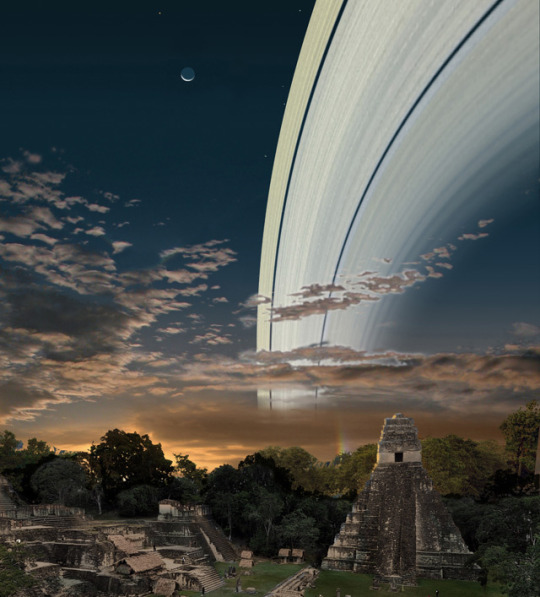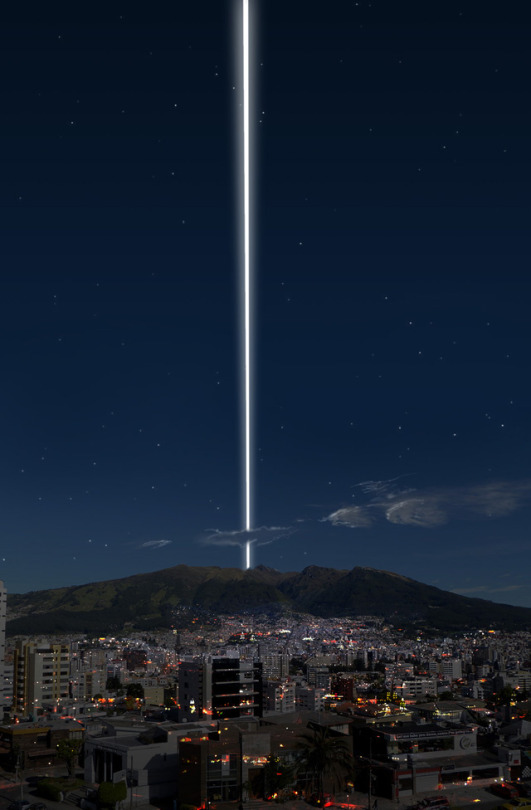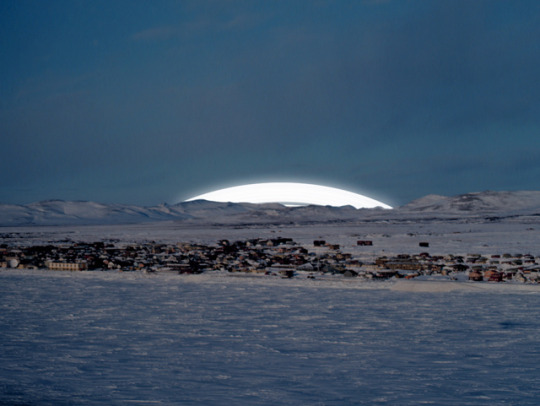Photo


The photo sequence in the upper image shows, left to right, a fluid-filled tube falling under gravity, impacting a rigid surface, and rebounding upward. During free-fall, the fluid wets the sides of the tube, creating a hemispherical meniscus. After impact, the surface curvature reverses dramatically to form an intense jet. If, on the other hand, the tube is treated so that it is hydrophobic, the contact angle between the liquid and the tube will be 90 degrees during free-fall, impact, and rebound, as shown in the lower image sequence. The liquid simply falls and rebounds alongside the tube, without any deformation of the air-liquid interface. (Photo credit: A. Antkowiak et al.)
709 notes
·
View notes
Photo



Thirty Meter Telescope
Near the center of Pasadena, California, a team of scientists, engineers, and project specialists is busily planning and designing what eventually will become the most advanced and powerful optical telescope on Earth. When completed later this decade, the Thirty Meter Telescope (TMT) will enable astronomers to study objects in our own solar system and stars throughout our Milky Way and its neighboring galaxies, and forming galaxies at the very edge of the observable Universe, near the beginning of time.
TMT will couple unprecedented light collection area with diffraction-limited spatial resolution.
TMT will couple unprecedented light collection area (almost 10 times more than one of the Keck telescopes) with diffraction-limited spatial resolution that exceeds Keck by a factor of 3. Relative to the Hubble Space Telescope (arguably the most revolutionary astronomical instrument of our generation), TMT will have 144 times the collecting area and more than a factor of 10 better spatial resolution at near-infrared and longer wavelengths.
The Telescope
In the TMT project organization, the “telescope” includes:
the main structures of the telescope mount and optical support assemblies;
the mechanical systems for the mount (drives, brakes, bearings, encoders, limit switches, counterweights, elevators, cable wraps);
the optical elements that form the telescope image (the primary, secondary and tertiary mirrors);
the mechanical assemblies that support and position the mirrors;
the control systems, including control electronics and software;
the alignment and phasing system; and
distribution systems for utility services, data signals, and grounding lines.
Other important systems, including the science instruments, the adaptive optics systems, the summit facilities and the enclosure, are not considered part of the telescope in our project organization.
Optics
TMT is a telescope designed for optical and infrared observing, with the wavelengths of interest ranging from 310 nanometers in the ultraviolet to 28 microns in the infrared.
Structure
The structure consists of two major components: the azimuth and elevation structures. The elevation structure provides a mounting for the telescope optics and the laser guide star facility (LGSF). The azimuth structure supports the elevation structure and two large Nasmyth platforms where the observatory instruments and adaptive optics systems are located.
Controls
TMT is the first ground-based observatory to be designed from conception with fully integrated active optic systems, adaptive optic systems, laser guide star systems, and instrument systems.
However, TMT will be the first ground-based astronomy telescope designed with adaptive optics (AO) as an integral system element.
The TMT design is a response to a set of science-based requirements developed by the TMT Science Advisory Committee (SAC), a committee of scientists representing all the TMT partners and (by extension) the future TMT scientific user community.
Why Thirty meter? In principle, arbitrarily large mirrors are possible. However, our analysis of AO technology development over the next ten years with respect to our detailed science goals suggests that D = 30 meters occupies an attractive and achievable scientific “sweet spot” at near-infrared wavelengths.
In July 2009, the board of directors of the TMT Observatory Corporation selected Mauna Kea as the preferred site for the Thirty Meter Telescope. This webpage serves as a central clearinghouse for information related to TMT in Hawaii.
Goal is to construct the Thirty Meter Telescope and bring it into operation in the next decade. The astronomy community, through its “decadal survey” of astronomy in 2001, called for this as the highest-priority large new project for ground-based astronomy.
TMT is a major research facility, and represents, along with the Atacama Large Millimeter Array (ALMA), a level of financial investment in astronomical observatories on the ground well beyond what has been done before.
1K notes
·
View notes
Photo

First “Bionic Eye” For the Blind To Be Available Later This Year
From Kurzweil Accelerating Intelligence:
"The Argus II is the first and only “bionic eye” to be approved in countries throughout the world, including the U.S. It is used to treat patients with late stage retinitis pigmentosa (RP). Argus II was developed by Second Sight Medical Products, Inc.
Argus II works by converting video images captured by a miniature camera, housed in the patient’s glasses, into a series of small electrical pulses that are transmitted wirelessly to an array of electrodes on the surface of the retina.
These pulses are intended to stimulate the retina’s remaining cells resulting in the corresponding perception of patterns of light in the brain. Patients then learn to interpret these visual patterns thereby regaining some visual function.”
Source
346 notes
·
View notes
Photo

Sketch by Anders Nilsen, whose book The End is out now.
197 notes
·
View notes
Photo

Sketch by Anders Nilsen, whose book The End is out now.
122 notes
·
View notes
Photo

Sketch by Anders Nilsen, whose book The End is out now.
170 notes
·
View notes
Photo





If Earth Had Rings
First off, they would be really pretty to look at. They would also dominate the sky in both night and day at exactly the same place as they would never rise nor set. And at night you would see the Earth’s shadow swing across the rings, like in the 4th photo here.
However, life would be very different on Earth if this were the case. Nocturnal animals would have a hard time being nocturnal, as the light reflecting from the rings would illuminate the night.
Because we are closer to the Sun than Saturn is, the rings would be more rocky than ice, making them less bright but still pretty bright. In fact, you would see far less stars at night (living anywhere other than the equator or the arctic circle) because of the light pollution and not to mention ruin most meteor showers because of that.
During the day the rings would block sunlight in certain regions of the planet creating wild weather cycles and effecting plant life as well. So basically, they would be definitely pretty to look at but they would also make a whole lot of things screwy.
Illustrations by Ron Miller // io9 — Click the photos for captions
47K notes
·
View notes
Photo

White and Black Magic
Here’s some Final Fantasy mages for you folks.
408 notes
·
View notes
Photo




Window Socket - Kyuho Song & Boa Oh
So this is an absolutley brilliant idea! Just attach the plug on to a window and it will harness solar energy. A small converter will convert it into electricity which can be freely used as a plug when you are in the car, on a plane or outside. Love this design and I really think it has a great potential.
108K notes
·
View notes
Photo






Source: http://aiwa-sensei.deviantart.com/
(thanks to everyone for letting me know the source! Aiwa-sensei has a ton of other art you might also like)
254K notes
·
View notes
Video
#
tumblr
ultimate hi five
89 notes
·
View notes
Photo
<3 Hell's kitchen & kitchen nightmares!










81K notes
·
View notes
Photo
NO, HIS HAT IS BACKWARDS.
YOU KNOW THAT MEANS THIS SHIT IS SERIOUS.




285K notes
·
View notes









